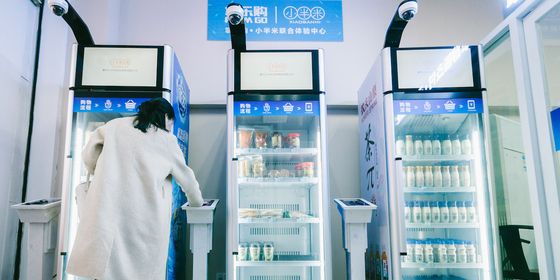Vehicle tracking chips, drone firefighters, and robo-deliveries. Welcome to the future—welcome to Tech Thursday
Each Thursday, The World of Chinese takes the most ground-breaking, impressive, or just plain weird technological advancements related to the Middle Kingdom and serves them in bite-sized chunks to keep you up-to-date on the latest news in the world of Chinese technology.
C.H.I.P.S.
From next year, all cars manufactured in China will require RFID chips, which track an individual’s location and other identifying data, such as registration and license plate, to be implanted as standard in every new vehicle’s windshield, reports the Wall Street Journal.
The tech is much like the EZ Pass commonly used to collect highway tolls in the US, except it’s not voluntary. Like a social credit score, everyone will eventually have one (unless they choose not to drive, in which case they can have their face scanned like an EZ Pass as they stroll down the street).
The chips will track checkpoints, rather than GPS, and the government says they are merely required to “ease traffic congestion and assist with public security,” though as some have pointed out, this usually requires only radar technology rather than electronic license plates…
Droned out
Forget firefighters—call the drone squad! A drone to help firefighters save trapped victims in high-rise buildings is apparently in the making at the China Academy of Launch Vehicle Technology (CALT).
Xu Jian, designer at CALT, told Xinhua that the drone has a higher efficiency of rescue compared with firefighters, since firefighters have to climb dangerous stairs with their sight considerably impeded by smoke and flames. “For a skyscraper with a height of around 500 meters, firefighters need roughly half an hour to climb to the top floor, whereas drones merely take two minutes,” Xu adds.
Other modern tech, such as a 3-D map and cameras, allow the drones to easily locate obstacles and transmit pictures back to firefighters, while the craft itself is made of materials commonly used in rockets that can withstand temperatures of up to 200 degrees Celsius. Xu said the drones would be put into use by the end of 2018.
Robo-drop
In other robot news, JD.com has launched a groundbreaking robot deliveries service in Beijing’s Haidian district (海淀区).
With a top speed of 15km/hr at maximum, and the ability to stop in front of traffic lights and avoid barriers along the road, the robots are already more efficient and safety-conscious than most pedestrians in Beijing.
When the deliveries reach their destination, customers receive an instant message, and can use facial recognition, passwords, or the JD.com app to access their parcel.
The bots got to work officially on the June 18 Shopping Festival after their trial run; JD plans to launch the bots across the city soon. Here’s something to add to the mix of cars, trucks, buses, trishaws, beng bengs, scooters, wagons, shared bikes, motorbikes, and suicidal grannies that make the capital’s streets so fun to navigates.
Google strategic partnership with JD
Speaking of JD.com, on Monday, Google announced plans to invest $550 million cash for delivery group JD.com to expand beyond China and Southeast Asia and to set up a presence in the US and Europe through Google Shopping.
Google will receive 27.1 million newly issued Class A shares at $20.29 each in return. Although this will give Google less than a one percent stake in JD, the partnership not only enables Google to support its retail ambitions in China, but also more ways to improve their relationship with Walmart, which Google has partnered with multiple times in the past. Analysts hope JD’s logistics and inventory management will partner well with Google’s market reach and analytics.











